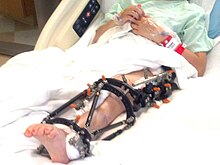
The Taylor Spatial Frame (TSF) is an external fixator used by podiatric and orthopaedic surgeons to treat complex fractures[1] and bone deformities. The medical device shares a number of components and features of the Ilizarov apparatus. The Taylor Spatial Frame is a hexapod device based on a Stewart platform, and was invented by orthopaedic surgeon Charles Taylor. The device consists of two or more aluminum or carbon fibre rings connected by six struts. Each strut can be independently lengthened or shortened to achieve the desired result, e.g. compression at the fracture site, lengthening, etc. Connected to a bone by tensioned wires or half pins, the attached bone can be manipulated in three dimensions and 9 degrees of freedom. Angular, translational, rotational, and length deformities can all be corrected simultaneously with the TSF.
The TSF is used in both adults and children. It is used for the treatment of acute fractures, mal-unions, non-unions and congenital deformities. It can be used on both the upper and lower limbs. Specialised foot rings (which are not seen in the picture) are also available for the treatment of complex foot deformities.[citation needed]